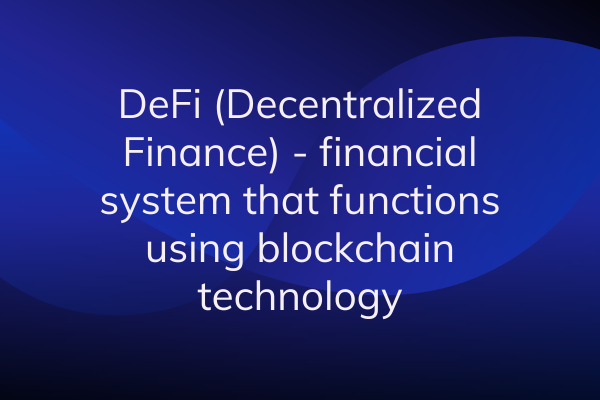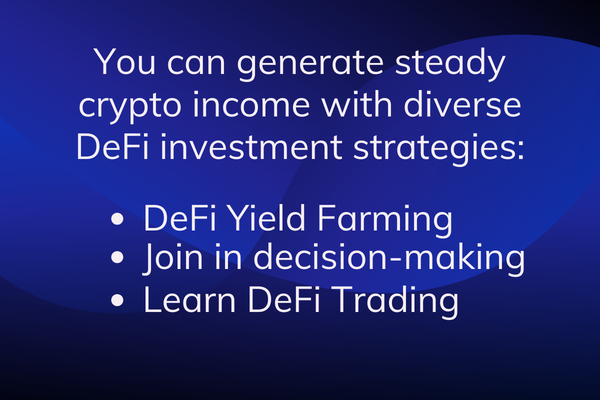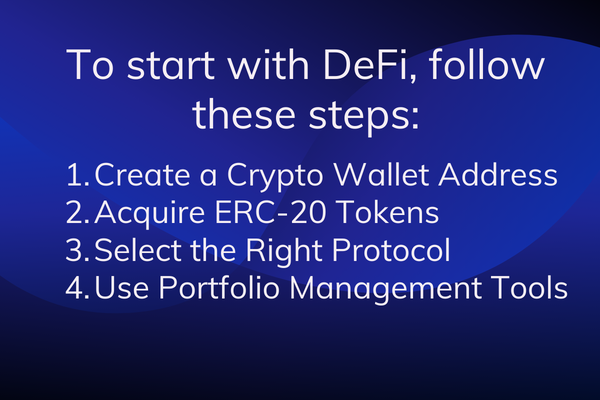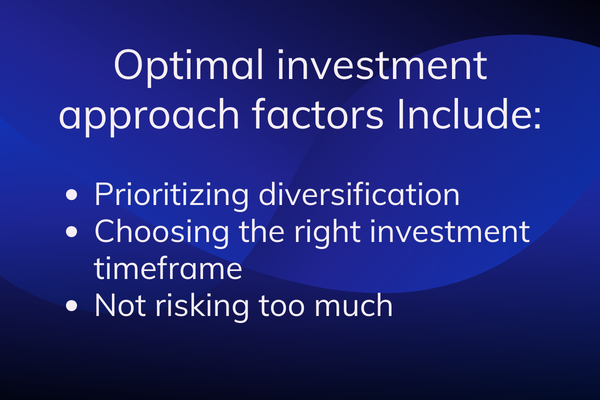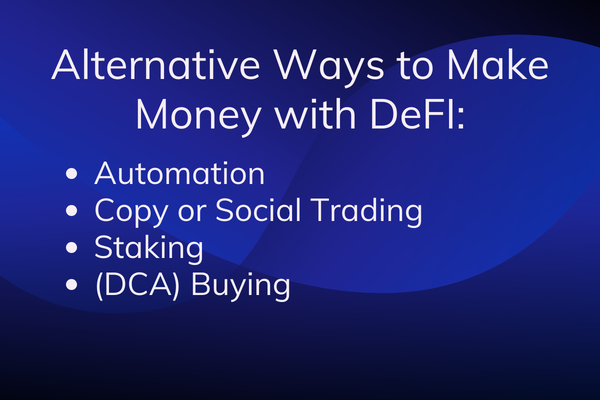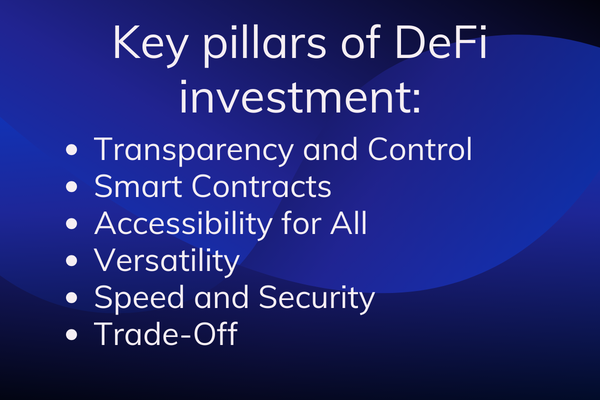How to Make Money with DeFi 2025
How to make money with DeFi and what it is – often ask those interested in crypto and funds.
Decentralized finance stands out as a pivotal outcome of the blockchain revolution. DeFi platforms represent groundbreaking solutions and offerings that reshape our understanding of monetary systems and financial transactions.
These platforms introduce distinctive investment prospects, enabling numerous individual traders to generate passive income.
Utilizing blockchain technology inspired by Bitcoin, DeFi eliminates the need for a central authority and allows multiple entities to hold a copy of transaction history. This decentralized approach gives users more control over their money and enables faster and more sophisticated transactions.
Decentralized exchanges (DEX) have gained popularity in the world of cryptocurrency. These platforms allow users to trade digital assets without relying on a centralized authority.
But how to use them and make income?
In this article we will:
- Understand DeFi and its Applications
- DeFi hacks and fraud prevention
- Talk about risks in the DeFi industry
- Also the updates in crypto industry developments, and more.
Key Highlights:
- Introduction to DeFi: Decentralized Finance (DeFi) eliminates intermediaries and central authorities in financial transactions.
- Decentralized Exchanges: Decentralized exchanges (DEX) have gained popularity in the crypto world, allowing users to trade digital assets without relying on centralized authorities.
- How DeFi Generates Income: DeFi platforms operate without central authorities, relying on user governance. Users participate in decision-making, enhancing the appeal of DeFi projects.
- Investment Strategies: DeFi offers various investment strategies, including yield farming, decision-making participation, and trading on decentralized and centralized exchanges.
- Getting Started with DeFi: The article provides steps to enter the world of DeFi, including creating a crypto wallet address, acquiring ERC-20 tokens, selecting the right protocol, and using portfolio management tools.
- Avoiding Scams: It highlights the importance of skepticism when encountering investment opportunities and warns against scams and get-rich-quick schemes.
- Choosing the Right Strategy: Investors are advised to diversify their portfolios, understand the risks associated with DeFi, and select the suitable investment timeframe.
- Risk Management: Investors should consider factors like value fluctuation risk, risks in smart contracts, and understanding returns when making DeFi investments.
- Don’t Risk Too Much: The article emphasizes the importance of not risking more than one can afford to lose and not putting all assets into a single investment.
- Alternative Ways to Make Money: It explores alternative methods to make money in the DeFi space, including automation, copy trading, staking, and dollar-cost averaging.
- The Revolution of DeFi Investment: The DeFi revolution is characterized by transparency, smart contracts, accessibility for all, and versatility. The trade-off between speed and security is discussed.
- Innovative Applications: DeFi applications like liquidity pools, lending platforms, and smart staking are highlighted as creative tools in the DeFi space.
- Technical Analysis: The importance of conducting technical analysis before investing in DeFi assets is stressed, as token values fluctuate over time.
- Diversification: Diversifying investments across various categories is recommended to build a well-balanced portfolio in the DeFi space.
FAQ
⭐ What is DeFi?
DeFi is a financial system that functions using blockchain technology. The main advantage of Decentralised Finance (DeFi) is that it eliminates the need for intermediaries or mediators. As a result, users can engage in various economic activities, such as borrowing, lending, and trading, without relying on central authorities.
⭐ How does Decentralized Finance work?
Decentralized finance (DeFi) utilizes blockchain technology to create a peer-to-peer financial ecosystem where users interact directly with smart contracts rather than relying on traditional intermediaries like banks.
⭐ Is Decentralized Finance safe?
Decentralized finance (DeFi) can offer security benefits, but it is only partially safe, as it is susceptible to smart contract vulnerabilities and potential hacks. Users should exercise due diligence and employ security measures to reduce risks when engaging with DeFi platforms.
⭐ How to invest in Decentralized Finance?
To invest in decentralized finance (DeFi), you can start by acquiring cryptocurrency assets, such as Ethereum (ETH), through a reputable exchange. Once you have the assets, you can participate in DeFi by using decentralized platforms to lend, borrow, stake, or trade these assets.
⭐ How to make money with DeFi?
To make money with DeFi, you can use yield farming, liquidity provision, and staking by using your cryptocurrency assets to earn interest or rewards on DeFi platforms.
Table of content
Understanding DeFi
DeFi, short for Decentralized Finance, goes beyond simple value transfers and transforms complex financial use cases.
Unlike traditional digital payment methods that rely on intermediaries, DeFi harnesses the power of digital-native assets like Bitcoin to eradicate middlemen from transactions.
This results in financial institutions having no authority to halt or interfere with transactions, marking a pivotal advantage of DeFi.
How Can It Generate Income?
DeFi, short for Decentralized Finance, represents a novel concept within the crypto industry, embodying a paradigm shift where control over financial interactions between users is relinquished to the community.
Decentralization, in this context, signifies the absence of a central authority overseeing users’ financial activities. Instead, all regulations and guidelines are determined collectively by the users.
Frequently, DeFi platforms employ diverse governance mechanisms, allowing token holders to participate in decision-making and vote on the network’s future implementations. This democratization enhances the appeal of DeFi projects, even when they have yet to yield profits.
The belief in their potential alone makes investing in these unconventional ventures worthwhile, challenging the conventions of traditional finance.
Conversely, DeFi investment offers an intriguing approach to utilizing one’s capital to support projects aligned with their vision. Many investors allocate their funds to promising DeFi platforms due to their shared vision of the future of finance.
Each product in this domain is built on smart contracts and digital agreements that are transparent and accessible to anyone. This system ensures adherence to consistent rules and discourages any malicious intent.
DeFi investment revolves around selecting the right platform that offers favorable returns and contributes to a brighter future for the industry.
One can establish a robust source of crypto passive income by employing various DeFi investment strategies:
- DeFi Yield Farming: Utilize this strategy to stake your tokens and receive returns based on percentages. Some staking programs provide payouts on a quarterly, semiannual, or annual basis.
While resembling traditional deposits, DeFi-based interest earning operates differently, with its unique advantages and disadvantages.
- Join in decision-making: Actively engage in the project’s governance, contributing to its growth and adoption. Those interested in asset appreciation can directly impact the platform’s development.
Many decentralized projects rely heavily on their governance model, allowing participants to shape the project’s evolution over time.
- Learn DeFi Trading: Explore opportunities for profit through trading on both decentralized and centralized exchanges. Automation and copy trading can enhance returns, with trading bots handling tokens issued by these platforms. A well-devised strategy can generate passive income in this arena.”
How to Start with DeFi?
Entering the world of decentralized finance (DeFi) may seem daunting to those unfamiliar with cryptocurrencies and blockchain technology. The array of initial setup requirements can be overwhelming, often discouraging newcomers.
However, DeFi is accessible, and starting your investment journey is easier than it may seem. You just need to follow a few simple steps:
- Create a Crypto Wallet Address
To begin, you’ll need a crypto wallet address. Most DeFi platforms operate on Ethereum or Cardano, so a Bitcoin wallet is unnecessary. A user-friendly option for Ethereum-based DeFi apps is MetaMask.
- Acquire ERC-20 Tokens
ERC-20 tokens are the standard for Ethereum-based assets. You can purchase them from either centralized or decentralized exchanges. If you plan to explore other networks, you’ll need to acquire the corresponding tokens. Our recent article can help you answer the question should you buy Ethereum now?
- Select the Right Protocol
DeFi offers a wide array of projects to support. It’s crucial to conduct research within the DeFi space and choose platforms that align with your investment goals, offering the best returns and consistent performance.
- Use Portfolio Management Tools
Managing investments across multiple platforms can be challenging. Utilize portfolio management tools to track the performance of your assets. This ensures a comprehensive overview of your holdings, particularly if you’re simultaneously engaged with various DeFi platforms.
By following these steps, you can confidently embark on your DeFi journey, making the process accessible and less intimidating for newcomers.
How to Make Money with DeFI and Avoid Scams
For novice investors lacking technical expertise, distinguishing fact from fiction can often seem insurmountable. Maintaining a high level of skepticism toward sudden investment opportunities is a prudent practice.
Scammers frequently employ sophisticated strategies that can confound even experienced retail traders, leading to unsuspecting victims.
An illustrative case is the recent incident involving the DeFi Smart Mining platform, which utilized a browser extension to connect with wallets—prompting considerable consternation within the crypto community.
Newcomers to the crypto sphere, often influenced by peers, might believe that mining represents the sole avenue for generating income in the industry.
However, it’s imperative to recognize that liquidity mining is the predominant form of mining in the DeFi domain. This straightforward process entails pooling funds with fellow investors to provide liquidity to favored platforms.
In return, users who stake their funds to generate liquidity are duly rewarded. This transparent and symbiotic relationship between users and platforms underscores its credibility, serving as a dependable method for engaging in DeFi endeavors. Also, our article on cryptocurrency exchange scams is worth a read.
How to Choose the Right Strategy?
Identifying the optimal investment approach can be quite challenging for those without prior cryptocurrency exposure. While aligning your choices with your risk tolerance is feasible, striking that elusive balance remains a formidable task.
Investing in decentralized finance (DeFi) products carries inherent risks and concealed pitfalls that can be elusive to the uninitiated.
Prioritizing Diversification
Diversification should occupy a prominent position on your investment checklist. However, crypto’s asset allocation strategies diverge significantly from the traditional financial paradigms that many have grown accustomed to over decades of engagement with traditional finance (tradfi).
To commence, you might contemplate employing diverse asset classes to establish a harmonious equilibrium between profitability and risk.
Rather than amassing many tokens, an alternative approach involves the dispersion of your portfolio across various DeFi platforms, exclusively utilizing Ethereum (ETH) as your foundational currency.
Conversely, diversification can extend to a broader spectrum by allocating funds to different categories of financial products.
Many retail traders opt for automation systems to generate passive income within the crypto sphere while concurrently focusing on accumulating an extensive portfolio spanning diverse coin types.
In the forthcoming discussion, we will delve into pivotal facets of investment management within the cryptocurrency industry and the expansive domain of DeFi platforms, providing valuable insights to facilitate informed decision-making.
Choosing the Right Investment Timeframe
Earning passive income in crypto can be like a dream come true. You buy tokens, stake them, and wait as the market bulls drive the prices to new highs.
But things don’t always go as smoothly as we hope. It’s crucial to be aware of the risks when investing in DeFi projects:
- Value Fluctuation Risk: When you lock your tokens on a platform, they may lose value. This is a significant risk that requires serious consideration. To make wise DeFi investments, it’s important to use technical and fundamental analysis to predict future trends.
- Risks in Smart Contracts: Even the best development teams can’t catch all the risks before updating smart contracts. If vulnerabilities are discovered while your tokens are locked or when you’re using a platform, it can greatly impact your profits.
- Understanding Returns: While high DeFi interest rates may seem tempting, it’s essential to remember that several factors affect your returns. Interest may be paid in newly issued tokens or by inflating the ecosystem. It’s important to understand how these high interests are achieved.
Due to the various risks that can affect your investments, choosing a specific period to lock your funds is essential. Compare the potential returns with and without staking, and consider the rewards you receive for participating in liquidity pools or lending your assets.
Although some investment methods may look good on paper, they may not be as efficient as others, such as using bots or staking in Proof of Stake (PoS) blockchain networks.
Don’t Risk Too Much: A Vital Investment Rule
The essential rule for investing is simple: only use money you can afford to lose. While this advice applies broadly to personal finances, it’s particularly relevant for those considering investments in decentralized finance (DeFi).
Avoid the All-or-Nothing Approach
Many newcomers to DeFi are enticed by impressive numbers and the promise of generous rewards, leading them to consider investing all their assets in these programs. However, DeFi platforms aren’t designed as get-rich-quick schemes.
If something appears too good to be true, it often operates like a pyramid scheme or an outright scam.
Balance and Risk
Having no backup plan or emergency fund can be financially devastating. Prioritizing providing for your family and addressing your personal needs is crucial before diving into investments.
Even if an emergency fund covers up to six months of expenses, think twice before going all-in on a single investment. DeFi platforms may seem promising with their high returns, but they often downplay potential risks.
It’s essential to see through the enticing exterior and view every DeFi project as just another financial asset.
Finding the Right Balance
The main objective for any sensible investor is to strike the right balance and manage risk effectively.
Here are some key considerations:
✔ Consider Price Volatility: When estimating passive income from crypto, account for potential price fluctuations. Use analytical techniques to predict price changes by the time you plan to withdraw tokens.
✔ Diversify Your Portfolio: Invest only a portion of your portfolio in DeFi platforms. The crypto industry offers various investment opportunities that can help diversify and hedge against risks associated with DeFi.
✔ Explore Different Platforms: Avoid focusing solely on staking or liquidity mining. Instead, invest in several distinct DeFi platforms, each offering unique products to avoid overlap.
✔ Emergency Plan: If you ever cannot withdraw funds when needed, consider selling your stake or locked holdings to other investors as a last resort. While not ideal, it can provide a solution in a pinch.
Remember, selling assets should be a last resort. To avoid such situations, prioritize safeguarding your personal financial situation and never exceed your investment threshold.
Tapping into funds meant for savings or emergencies can adversely affect your well-being.
Alternative Ways to Make Money with DeFI
Learning how to make money with DeFi is valuable, and you don’t need to be a financial expert to navigate this decentralized world efficiently.
However, it’s crucial to recognize the risks inherent in investing in emerging financial instruments. Diversify your portfolio by incorporating other investment methods.
- Automation
Leveraging bots to automate various technical analysis strategies is an effective way to create an additional income stream. Bots are particularly well-suited for the crypto market, which operates continuously, with transactions executed in fractions of a second.
Automation can be a valuable addition to your portfolio if you possess a reliable strategy that generates consistent signals.
- Copy or Social Trading
Certain automation providers, such as WunderTrading, offer a range of services. This particular platform features a special marketplace where users can select from experienced retail traders.
If you believe these traders can outperform the market, you can follow their lead and replicate their investment actions, effectively copying their strategies.
- Staking
Blockchain networks like Cardano and Ethereum allow users to become validators by staking their native tokens, ADA and ETH, respectively.
While staking on the Ethereum network may require a substantial minimum of 32 ETH to run a node, it offers a reliable source of passive income for investors.
- (DCA) Buying
Dollar-cost averaging is a prudent approach to accumulating assets. Many investors favor this method to acquire financial assets at an average lower cost, gradually building their portfolios with the expectation of long-term appreciation.
Revolution of DeFi Investment
In the ever-evolving landscape of contemporary investing, the DeFi (Decentralized Finance) revolution takes center stage.
This transformation revolves around key pillars:
Transparency and Control
In the world of contemporary investing, transparency is a key attraction, and this is precisely what DeFi platforms prioritize. Investors gravitate towards these decentralized entities because they want direct control over their capital. A vital aspect of this democratic appeal lies in governance.
Smart Contracts
Smart contracts, these digital agreements, hold a plethora of features and functions, depending on a platform’s objectives. The beauty of these contracts lies in their presence on the blockchain ledger, granting investors immediate access to real-time information.
Accessibility for All
Thanks to user-friendly blockchain crawlers and explorers, even retail traders with no technical background can comfortably navigate the publicly available data. This accessibility empowers them to make informed investment choices after conducting thorough research.
Versatility
Smart contracts are incredibly versatile, allowing platforms to offer an array of products and services that often surpass what traditional finance can provide. However, a significant challenge looms in the form of security:
Speed and Security
For DeFi platforms to achieve speedier transaction processing, they often implement measures that relax security protocols, potentially exposing them to external and internal attacks, leading to fund losses and service interruptions.
Trade-Off
Enhancing security features and enabling meticulous transaction scrutiny can significantly slow down the process. The trade-off between speed and security sparks debate among DeFi proponents and opponents. Nevertheless, smart contracts remain a potent tool for offering diverse solutions to DeFi users.
Innovative Applications
Innovation knows no bounds within the dynamic landscape of Decentralized Finance (DeFi).
These groundbreaking applications redefine how users interact with their financial assets:
- DeFi Liquidity Pools: Witness the power of collective action as users unite their assets in DeFi liquidity pools, amplifying trading volumes and ensuring liquidity across platforms. Transparent smart contracts empower participants to monitor pool performance while liquidity providers are duly rewarded.
- DeFi Lending Platforms: Step into a realm of financial empowerment where DeFi lending platforms automatically extend credit lines to users based on versatile parameters. Explore novel features like ultra-short loan expiration periods, facilitating swift trading and seamless cross-network transactions.
- Smart Staking: Embrace the future of decentralized finance through smart staking, where stakes become integral to network performance metrics. On platforms like Ethereum, stakeholders metamorphose into validators, while others leverage staked funds for development and liquidity enhancement. Dive into the world of yield farming, seamlessly monitored through smart staking.
Technical Analysis
While some may perceive staking and other passive DeFi investment methods as distinctly separate from trading, it’s essential to remember that the value of tokens fluctuates over time.
This means that conducting a thorough technical analysis remains crucial before investing in any digital asset.
Tokens used for staking or liquidity mining may increase in value, yielding substantial profits. Conversely, they can also decrease in value, leading to significant financial setbacks and losses that may not be easily mitigated.
Hedging is a valuable strategy to safeguard your portfolio against these risks. However, it’s equally important to predict the market’s future and anticipate potential changes that may occur when your tokens become available.
While technical analysis cannot guarantee precise predictions, it provides valuable insights when making critical investment decisions.
A final tip for crypto investors is to diversify your investments across various categories and allocate portions of your funds to each. Consider investing in DeFi, staking tokens, utilizing multiple Dollar-Cost Averaging (DCA) bots, and exploring different forms of automation.
Key Takeaway
Decentralized finance represents an exciting ecosystem that introduces millions of modern investors to a fresh class of financial assets.
Nevertheless, it’s essential to exercise caution and avoid investing everything in a single promising DeFi platform. Instead, prioritize diversification and aim to construct a well-balanced portfolio.
So, how to make money with DeFI? The whole process involves strategies such as liquidity provision, yield farming, lending, staking, and using DeFi apps. Managing risks, staying informed, prioritizing security, and being aware of legal and tax considerations are essential.


